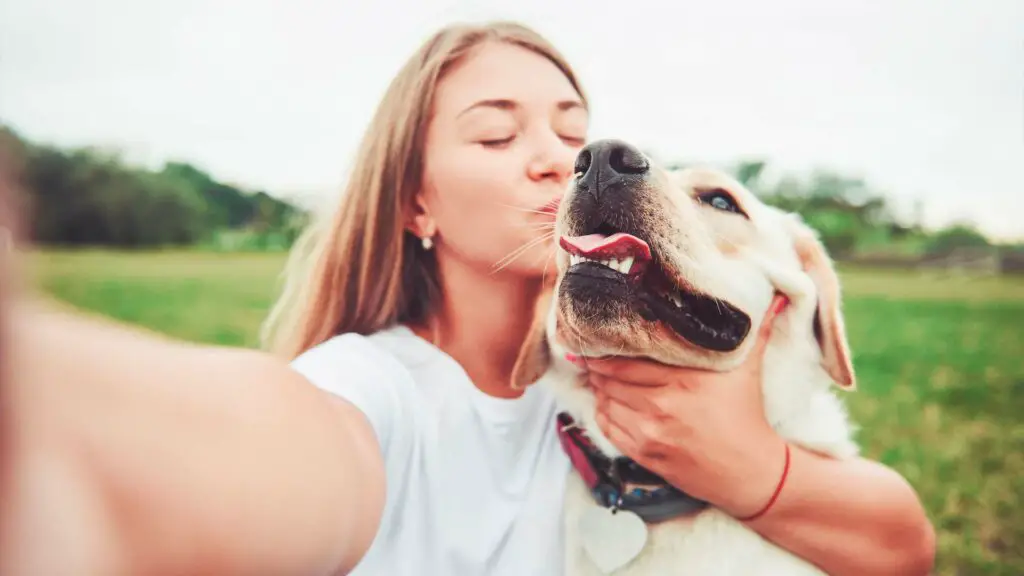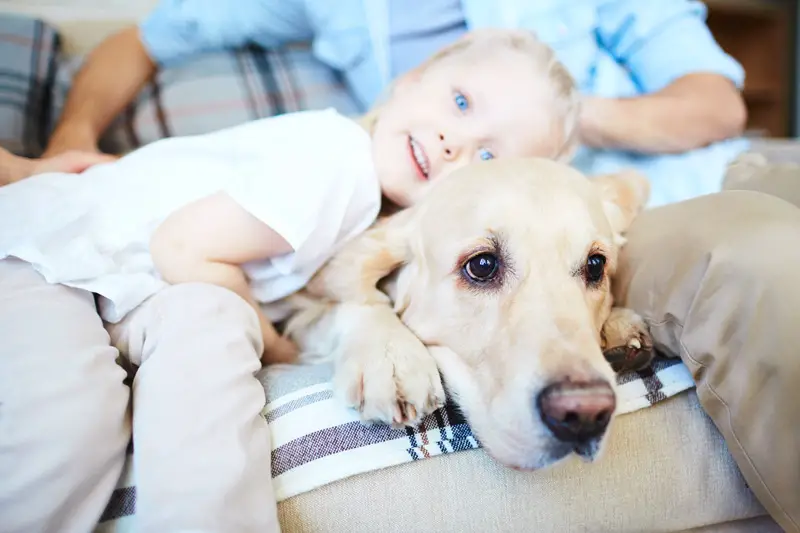Labradors are one of the most lovable breeds of dogs on our planet. They rank number three on the most popular dog breeds in 2022. For over 30 years the Lab has been the most popular dog breed in the United States based on the American Kennel Club (AKC) registrations. However, in 2022 the Lab achieved the bronze medal position of the most popular dogs in the world. Most people believe that the Labrador is from Labrador Canada, but they are actually from Newfoundland Canada. Labrador Retrievers are easily recognized by their broad heads, drop ears and large expressive eyes.
Labrador Dog Training: (Step By Step)

They are excellent swimmers
Labs absolutely love to swim. Not only do they love it, but they are insanely good at it. Labs are another dog which has two coats. They have a noticeably short yet thick double coat to help them swim. This double coat is water repellent. They also have a straight, thick, and sturdy tail which is known as the “otter tail.” Their feet are the most important part. They have webbed feet which means they have longer skin between their toes to help aid them in swimming. They like to swim because they have been bred to swim in freezing waters to help retrieve animals or humans.
They were originally bred to be hunting dogs
Labs started out as duck retrievers but then in the 1800s the British bred them for game-hunting companions. Today, they are excellent retrievers who work in many forms from waterfowl hunting to game hunting. They can keep this up for hours at a time because they love the thrill of the hunt!
They have an amazing nose
Labradors have exceptional noses and can smell just about anything. Not only can they smell food from miles away, but they can also sniff out illnesses in the human body. They can sniff out cancer and other nasty diseases and even tell when an epileptic is about to have a seizure.
They need quite a bit of exercise
On average, a Labrador needs about one hour of exercise each day. While Labs love to go on walks, they need to do more to keep them healthy. You could take them swimming, for a run, or even play fetch. Labradors are an extremely high energy breed. By giving them their needed exercise, it will keep their muscles strong, their minds stimulated, and their weight under control. If they lack the exercise they need, Labs will resort to digging, biting, and barking. This is why they need an outlet for all their pent-up energy.
They are a decent height, and they weigh a lot
An average Lab height about 21.3-22.4 inches. This is just under two feet tall. They are about 10 inches shorter than a Great Dane and about the same size as a Border Collie. While they are not the tallest breed in the world, they are definitely not short! Did you know that in just two short years a Lab stops growing? They grow to be between 60-85 pounds. They have a fun filled spirit, but they are definitely not lap dogs.
They shed a lot
A Labrador retriever is another breed of dog that is non-hypoallergic. Dogs with double layered coats will always shed more than a single coated dog, especially the lab. Due to their coats being crafted for swimming, they are bound to shed like crazy. Double check everyone’s allergies before making an impulse buy due to their cuteness.
Labradors are cost effective
A Labrador Retriever puppy is likely to cost between $400-$1,500 with the average price being $800. If you are looking for a show quality puppy expect to pay a little more because an average show puppy is $2,000. What I bet you did not know is that different color labs cost different amounts. A Yellow Lab is the most expensive with an average cost of $1,500. Following closely behind is the Chocolate Lab with an average cost of $1,250. Lastly comes the Black Lab with an average cost of $1,200. Age and status also play a huge role in how much your puppy will cost.

They have a semi-long lifespan
On average, a Labrador Retriever lives about 10-12 years. While this is their average lifespan, it can vary depending on the Labrador’s color, breeding, and individual health conditions. Since Labrador Retrievers are a large-breed dog, they do not normally live as long as their smaller breed counterparts. With this in mind, it does not mean that they have a short lifespan. If you keep your Lab on a proper diet, give him an hour of exercise a day, and treat any health issues, your pup could live to 12 years of age, or even longer.
They have health issues
There are a variety of health issues that come up within Labs. The most common problems are joint pains, obesity, ear infections, and heart disease. Many Labs suffer from joint pain such as hip or elbow dysplasia. This is not completely preventable, but it is lessened with a healthy weight and proper exercise. Obesity is quite common in many dogs including Labs. Thankfully, obesity is very easy to monitor! Make sure to portion your dog’s food so over eating is not an option. Labs are known for their floppy ears, however, their large and floppy ears provide a breeding ground for bacteria which makes them more prone to ear infections. Make sure to clean you dogs ears periodically. Heart disease is also very common in Labradors. To stay up to date with your dog’s health, make sure to take your Lab to scheduled vet appointments.
They are intelligent
Labs are very energetic and a lovable breed of dog. On top of this, they are the seventh smartest dog when it comes to obedience and working intelligence. The average intelligent dog breed is capable of learning a new command with just 25-40 repetitions, but a Lab is five times faster at learning new commands! While a lab is not as smart as a Border Collie, they still rank high in intelligence.
Training techniques, tricks, and tips

As usual, the best time to train your Labrador is when you first get them! While each dog is different there are basic milestones that should be met when you start training your newborn lab. As an old or new dog owner, it is beyond important and is your responsibility to make sure your dog is trained well and properly. There are major milestones to be met at 2 months, 3-6 months, 7-11 months, and 12 months.
8 Weeks (2 month) milestones
Before you bring your puppy home for the first time, make sure you make your house a safe haven for your new Lab. This means that you need to puppy proof the whole house. Labradors are very energetic so they will most likely jump or run into table corners. Put some rubber protectors on any sharp points that your new Lab might encounter. Also make sure to keep your valuables and precious items out of reach from your Labrador as well.
Once you have brought your puppy home, potty training becomes the most important thing that needs to be taught. Start this by immediately bringing your Labrador outside after they first wake up. After that, make sure you start letting them out every 30 minutes on the dot. In order to increase their understanding of when and where they should go, guide them to the same spot every time so they know that this is where they should go to the bathroom.
Once your Lab has gotten used to being at their new home, make sure to start socializing your dog. Socialization is very important for any breed of dog, especially one with such high energy. It is imperative that you introduce your pet to other people and pets in the house. When you first do this, keep an eye on your puppy. Make sure that any hostility between animals is corrected immediately.
Next, get your puppy accustomed to grooming from this early of an age. This includes giving them baths, trimming their nails and cleaning their ears. Getting them used to grooming at an early age will help prevent any problems in the future. They will not feel uncomfortable later in life when someone goes to take care of them or tries to groom them. Labs should be groomed once a month.
Basic training is all a Lab can understand within two months. Start with “sit”, “down”, “stand”, and “heel.” As they grow throughout their first year, you can teach them more but make sure you start with the basics.
3-6 month milestones
This is the age where you notice an immense amount of teething. They will start biting everything around the house because they will not know better. Make sure not to encourage their behavior by giving them toys to chew on instead.
As soon as your puppy has completed its first round of vaccinations, you can already enroll them in obedience training classes. Aside from being taught more complex commands, they undergo further socialization since they are being introduced to other dogs in these classes.
In this time frame, take your puppy on some walks with a leash! When I say walk, I mean walk. At this age your puppy’s bones are still developing and are not strong enough for long runs yet! So, feel free to increase their walking time, just remember not to run!
This is a fun age because now you can start teaching your puppy command training! Introduce your puppy to “leave it” and “wait.” Use “leave it” when you want your puppy to drop something that they have in their mouth. This will also help prevent your Lab from eating whatever they lay their eyes on. Use “wait” when they are far ahead of you, and you need to catch up with them. “Wait” will also keep your dog from eating before they are allowed to.
7-11 months milestones
Unfortunately, puppies reach sexual maturity a lot faster than humans. It is during these four months that your puppy will start their sexual maturation. They will not reach sexual maturity until about 22 months to two years. Female labs will start to have their periods so make sure you have diapers! Also make sure that you avoid training activities during this time. Neutering or spaying should be discussed with your vet. The recommended time for this procedure is to be done at around 18 months to allow full closure of your puppy’s growth plates.
12 months (one year) milestones
On your puppy’s first birthday, you can already transition them from puppy food to adult dog food. Make sure to consult with your vet on the best feeding schedules for your dog.
Because your dog is fully developed at this time, you can finally take them outside for 30-minute to hour long walks. It is also safe to run and jog with your Lab. By one year your dog’s bones are a lot stronger. While this means you can take them for runs, you can also play games with them and run around your backyard playing fetch or even wrestle them.
Training tips
- Make training a habit
- Train them in chunks
- Let your Labrador choose their own reward
- Mark down your dog’s milestones
- Keep the training simple
- Praise your Lab and do not punish them
- Train your lab with treats
- Expect the unexpected
- Be reasonable
- Practice makes perfect
- Always ask for help when you need it
- Stay positive no matter what happens
Labradors are one of the most fun-filled breeds of dogs out there. Training can be tough not only on you the owner, but it can also be hard on your dog as well. Always make sure to take deep breaths and have patience with your Lab. At the end of the day, they just want to make you happy. If you are struggling, there are many people that can help you. Reach out to a training center or ask questions online. You are not by yourself. Remember, teamwork makes the dream work.



